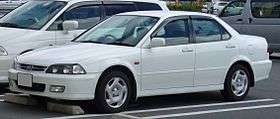Honda Torneo
The Honda Torneo is a sedan introduced by Honda in 1997, exclusively for the Japanese domestic market, derived from the Honda Accord. While the Accord was sold exclusively at Honda Clio dealerships, the Torneo was available at the other two Honda networks, Honda Verno and Honda Primo as the successor to the Honda Ascot and Honda Rafaga, respectively. "Torneo" means tournament in Spanish.
| Honda Torneo | |
|---|---|
 | |
| Overview | |
| Manufacturer | Honda |
| Production | 1997–2001 |
| Assembly | Sayama, Saitama, Japan |
| Body and chassis | |
| Class | Mid-size car |
| Body style | 4-door sedan |
| Layout | Front-engine, front-wheel-drive |
| Related | Honda Accord (sixth generation) |
| Powertrain | |
| Engine | 1.8 L F18B VTEC I4 2.0 L F20B SOHC VTEC I4 2.0 L F20B DOHC VTEC I4 2.2 L H22A DOHC VTEC I4 |
| Transmission | 4-speed automatic 5-speed manual |
| Dimensions | |
| Wheelbase | 2,665 mm (104.9 in) |
| Length | 4,680 mm (184.3 in) |
| Width | 1,720 mm (67.7 in) |
| Height | 1,440 mm (56.7 in) |
| Curb weight | 1,390 kg (3,064 lb) |
| Chronology | |
| Predecessor | Honda Rafaga Honda Ascot |
| Successor | Honda Accord (Japan and Europe seventh generation) |
The introduction of the Torneo continued the original approach Honda used in 1982, with the introduction of the Honda Vigor in offering a unique variant of the Accord, for each of the three dealership Honda sales channels with the sportier Torneo, utilising a different front grille, headlights and tail lights, and exclusive trim packages and color choices.
With the release of the seventh generation Accord in 2002, the Torneo nameplate was discontinued. However, the seventh generation Accord assimilated much of the sportier character of the Torneo, making it effectively the successor of the Torneo as well as the previous generation Accord.
Trim levels and engines
The Torneo was available with HID headlights, which were uncommon at the time. Four engines were available, all equipped with Honda's VTEC technology. A few sport packages were available, including the "Euro R", the "SiR-T", and the "SiR Euro".

The Euro R included an H22A engine rated at 220 bhp (164 kW), five speed manual transmission, Recaro seats, leather wrapped MOMO steering wheel, helical Torsen LSD, sports suspension, sports exhaust (including 4–2–1 stainless headers) and an aluminium alloy gear shift knob.
It was also fitted with a unique factory body kit that included flares and was available in some colours not available to lower trim package Accords (such as Milano Red). The Accord and the Torneo are the same car, aside from minor cosmetic differences in the exterior. All trim levels were installed with Honda's internet based navigation system called Internavi.
SiR-T (CF4, 1997–2000)
The SiR-T model included a 2.0L F20B engine rated at 200 PS (147 kW; 197 hp) at 7,200 rpm (180 PS (132 kW; 178 hp) automatic) and 144.5 lb⋅ft (196 N⋅m) of torque at 6,800 rpm, 11.0.1 compression, 85 mm X 88 mm (Bore and Stroke) 7,800 rpm redline. The H Series DOHC VTEC engines were limited to 7,800 rpm.
The F20B had a unique blue valve cover and like all the larger displacement Honda engines, the F20B was mounted with a tilt towards the driver. F20B engines could rev at higher rpm than H22As because it had a shorter stroke. The F20B had an 85 mm x 88 mm bore and stroke when compared to an H22A which had an 87 mm x 90.7 mm bore and stroke. The F20B was also classified as a low emissions engine.
SiR (CF4, 1997–2001)
The Accord SiR was based on the SiR-T, but used the S-Matic automatic transmission with sequential manual shift mode. The engine was rated at 180 PS (130 kW; 180 hp) but with better mid range characteristics. Moving the gear stick over to the right allowed manual selection of first, second, third, or fourth gear using up and down shift actions.
The manumatic feature would hold the gear up to the rev limiter as a manual transmission would.
Demise
As sales of the Accord proved more popular than the Torneo, plus the economic effects of the Japanese asset price bubble or "bubble economy", the Torneo was discontinued in 2001, along with the dissolution of Honda's three dealership networks Verno, Primo, and Clio three years later. The succeeding Accord also effectively assimilated the sportier character of the Torneo into one car.
External links
| Look up torneo in Wiktionary, the free dictionary. |
| Wikimedia Commons has media related to Honda Torneo. |
- Honda Torneo History (Japanese)
- Honda Torneo Product Description (Japanese)
- Honda Japan TV commercial for the Torneo